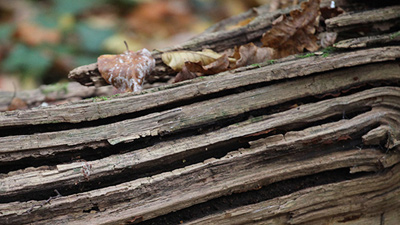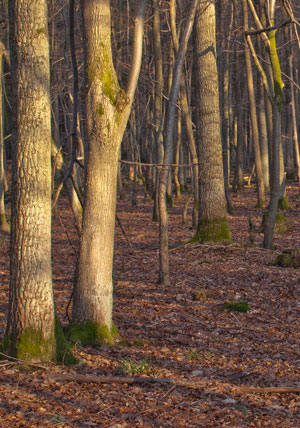The mixed oak forest
Under natural conditions the tree combination and the composition of shrub and herb layer of our forests is determinated by climate and soil conditions. Without human activity, European beech would dominate the landscape in Central Europe.
However, the beech does not tolerate wet soil conditions, which can be found during wintertime in large areas of the Ville-forests. The soils are temporary waterlogged (technical term Pseudogley or Planosol, Stagnosol) because of an impermeable layer of clay in the sub¬soil. These soils fill up with water in winter, while they are mainly dry in summer. The pedunculate oak copes much better with this soil conditions and forms impressive old-growth mixed forests in combination with hornbeam and small-leaved lime. This natural forest habitat of European importance is called ‘oak-hornbeam-forest on hydromorphic soils’.
The oak-hornbeam-forest in the course of the year
When the first rays of sunshine warm the ground in early spring, the forest soil locally turns into a bright green and blooming carpet. Starting in the end of March the grove windflowers sprout and their white star-shaped blossoms cover the ground in April. On closer inspection more herbs such as the greater stitchwort and the lily of the valley can be found. The white flowers of the wild cherry are the first heralds of spring in the canopies. 
This magical moment is already over when the oak leaves appear in Mai. Now the scene is dominated by the summer green herbs and grasses like wood millet, common lady-fern and enchanter's-nightshade. The species diversity depends on the amount of light that falls through the canopy to the forest ground. When hornbeam and lime form a further tree layer under the oak´s canopy a herbaceous layer is barely there.
If the trees have flowered successfully in spring, autumn is harvesting time in the oak forests. In October acorns fall down with autumn leaves together with the beechnuts and the fruits of hornbeam and small-leaved lime. However, the quantity of fruits varies widely from year to year because the blossom depends on the tree species and weather conditions.
How old our oaks may be?
 500 or 1000 years? We do not know exactly because since the middle ages all oaks in the Ville-forests have been harvested before they could have reached their natural end.
500 or 1000 years? We do not know exactly because since the middle ages all oaks in the Ville-forests have been harvested before they could have reached their natural end.
A natural forest includes all stages of life of a tree from seedling through to the impressive tree to the decaying deadwood. In the oak-hornbeam-forests, the various senescence stages can be observed in close proximity to one another. Over 200 years old oak trees are growing beside young hornbeams and groups of natural regeneration can be found almost everywhere. But deadwood and habitat trees are missing due to forest management. The LIFE+ project will bring it back in sufficient quantity.
 Oak as a habitat
Oak as a habitat
The ecological importance of pedunculate and sessile oak is impressive. On old-growth living trees or standing deadwood you can find about 400 butterflies and more than 1000 beetle species, including about 500 wood-dwelling beetles. Also a lot of birds benefit from oaks particularly the middle spotted woodpecker.





